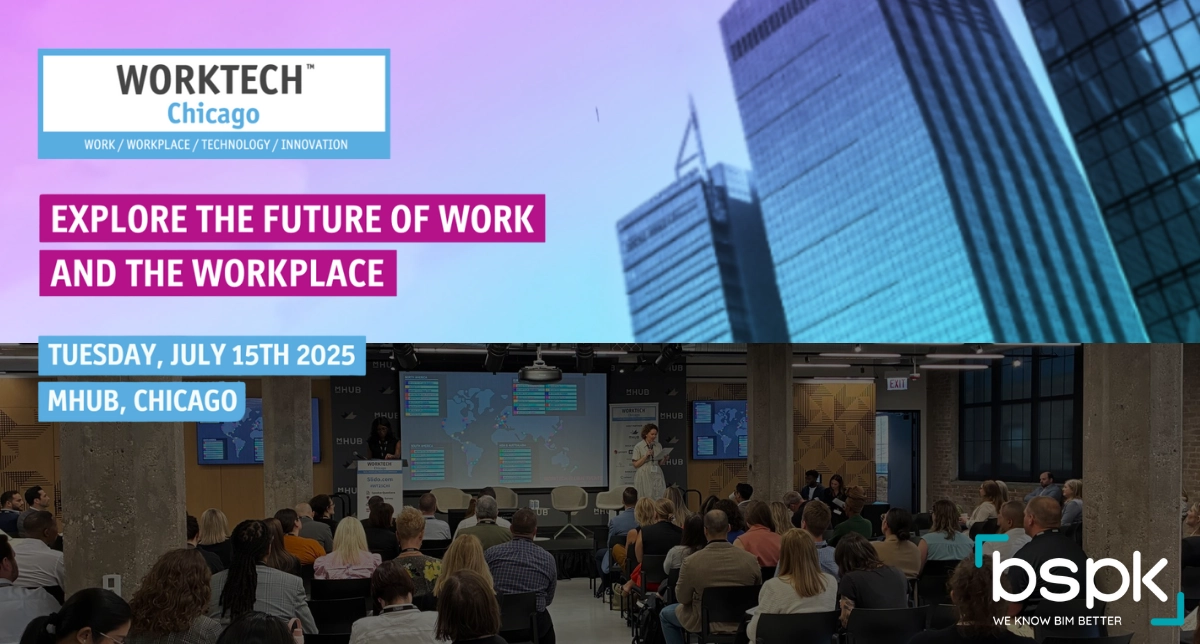This July, Worktech Chicago 2025 brought together industry leaders to discuss the future of workplace design and construction. Beyond the trends and technologies showcased, the event highlighted a critical reality: modern workplace projects are impossible to execute successfully without comprehensive BIM coordination.
The complexity behind flexible workplaces
The “flexible workplace” sounds simple in theory, but the construction reality is far more complex. A single open office area might need to accommodate multiple HVAC zones, dynamic lighting systems, flexible power distribution, integrated AV technology, and acoustic treatments—all while maintaining the ability to reconfigure spaces as business needs change.
This is where BIM becomes essential. At BSPK, We Know BIM Better, and we’ve seen firsthand how proper coordination can make or break these projects. Without detailed 3D modeling and clash detection, teams discover conflicts during construction that cost weeks of delays and thousands in change orders.
Why architects need BIM for workplace design
Conference discussions emphasized adaptability, but adaptable design requires precise planning. BIM enables architects to model multiple workplace scenarios within a single framework—testing everything from collaborative zones to private focus areas before construction begins.
At BSPK, we don’t just model buildings—we model better decisions. Our team helps architects visualize how different workplace strategies impact building systems. When designing a corporate headquarters renovation, we modeled various layout options that revealed how different configurations would affect HVAC distribution, electrical loads, and natural light patterns. This analysis informed design decisions that saved the client from costly mid-construction changes.
MEP coordination in technology-rich environments
Modern workplaces are technology-intensive environments. Conference rooms need integrated AV systems, air quality monitoring, and flexible power distribution. Open areas require sophisticated lighting controls and acoustic systems. These requirements create unprecedented coordination challenges for MEP engineers.
BIM provides the precision needed to coordinate these complex systems. Our experts have coordinated MEP systems where a single conference room required integration of fifteen different building systems. Our 3D models identified over 200 potential conflicts before construction—conflicts that would have been discovered too late using traditional 2D coordination methods.
The digital twin foundation
Conference speakers discussed digital twins as the future of workplace management, but effective digital twins require accurate BIM models as their foundation. You can’t monitor and optimize what wasn’t properly modeled during design and construction.
We understand that digital twins begin with comprehensive BIM coordination. Our detailed modeling creates the data foundation for intelligent building systems that monitor space utilization, energy consumption, and system performance throughout the building’s lifecycle.
Project coordination challenges
Workplace projects now involve unprecedented coordination between disciplines. A typical renovation might require coordinating architectural changes, MEP upgrades, technology infrastructure, furniture systems, and acoustic treatments—all while maintaining building operations.
That’s exactly what BSPK was built for. Our experts specialize in this complex coordination. For a recent 40,000-square-foot office renovation, our BIM coordination identified over 300 potential clashes between new systems and existing infrastructure. This proactive approach prevented delays that would have extended the project timeline by months.
The BSPK advantage in workplace construction
Events like Worktech Chicago showcase workplace trends, but successful implementation requires the technical expertise to coordinate complex building systems. That’s where comprehensive BIM coordination becomes essential.
Whether you’re designing adaptive office spaces, coordinating technology-rich MEP systems, or managing integrated building systems, our BIM expertise provides the foundation for successful workplace transformation projects. Because in the rapidly evolving world of workplace construction, knowing BIM better isn’t just an advantage—it’s essential.
Ready to discuss your next workplace project? Our team brings the BIM coordination expertise that makes complex workplace transformations possible.



